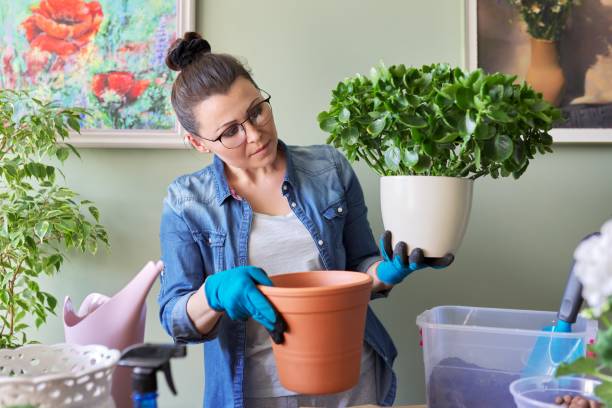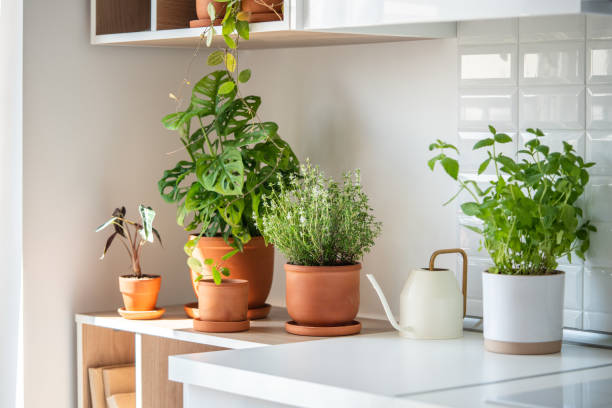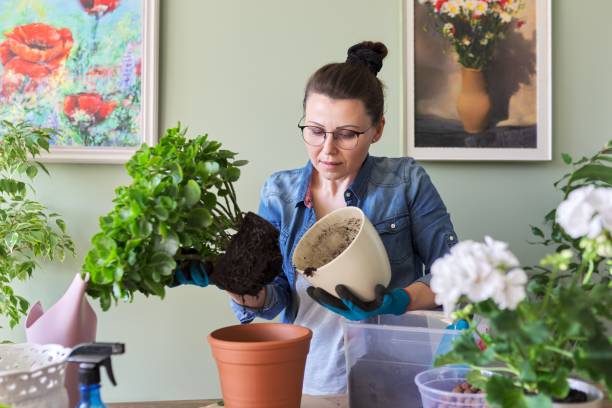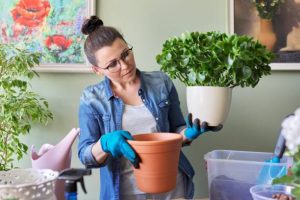Which pot is best for your indoor plants? Choosing the right pot can make your plants happy and healthy. When I first started growing indoor plants, I made many mistakes. I picked pots just because they looked pretty. But soon, I realized that the right pot is more than just decoration. It affects how much water the plant gets, how its roots grow, and even how long it survives.
Some pots hold too much water, while others dry out too fast. Some are too small, and some are too big. After years of trial and error, I have learned what works best. In this article, I’ll share my experience to help you choose the right pot for your indoor plants.

Best Pots for Indoor Plants
Factors to Consider When Choosing a Right Pot for Your Indoor Plants
I have learned that picking the right pot is important. The wrong pot can harm a plant and stop it from growing well. A good pot keeps the plant healthy and makes care easier. Over time, I have tried many pots and found what works best.
1. Pick the Right Size
The size of the pot matters a lot for plant growth. A small pot can stop roots from spreading, and a big pot can hold too much water. I always choose a pot that is 1-2 inches larger than the current plant root ball. This gives the plant space to grow without drowning it in extra soil. If the pot is too big, the soil stays wet longer, which can cause root rot.
2. Choose a Pot with Drainage Holes
Drainage holes help water escape so the roots do not rot. If a pot does not have holes, water collects at the bottom. This makes the roots weak and can kill the plant. I always check for at least one drainage hole before buying a pot. If I find a pot I love without holes, I drill some myself.
3. Decide on the Material
Pots come in different materials like plastic, ceramic, and terracotta. Each type has its pros and cons. I use plastic pots for light weight and easy movement. They also hold moisture well. Terracotta pots are great for plants that like dry soil, like cacti. They absorb extra water and keep the roots from staying too wet. Ceramic pots look pretty but can be heavy and break easily.
4. Think About the Plant’s Needs
Different plants need different types of pots. Some plants like dry soil, while others need more moisture. I use terracotta pots for succulents because they help the soil dry faster. For ferns, I pick plastic pots because they keep the soil damp longer. Knowing what my plant likes helps me pick the best pot.
5. Check the Pot Depth
Some plants have deep roots, while others spread out near the surface. A deep pot is best for plants like snake plants and palms. Shallow pots work well for herbs and succulents. I always check how the roots grow before choosing a pot. This keeps my plants healthy and strong.
6. Consider Self-Watering Pots
Self-watering pots help plants stay hydrated without overwatering. These pots have a water reservoir at the bottom. The plant absorbs water as needed. I use these for plants that need constant moisture, like peace lilies. They make watering easier and prevent the soil from drying out too fast.
7. Use Pot Liners for Easy Repotting
I use pot liners to make repotting easy and mess-free. A pot liner is a thin plastic or fabric layer inside the main pot. It holds the soil together when moving plants to a new pot. This helps avoid root damage and keeps things tidy.
8. Match the Pot to Your Home Decor
While plant health is my priority, I also like stylish pots. A good-looking pot adds charm to any room. I pick colors and designs that match my home. Neutral-colored pots go well with most decor. If I want a bold look, I choose bright-colored or patterned pots.
9. Check for Pot Weight and Mobility
Some pots are heavy, especially ceramic and terracotta ones. If I need to move my plant often, I choose plastic or fiberglass pots. Lightweight pots are easy to carry and rearrange. For big plants, I sometimes use pots with wheels to make movement easier.
10. Avoid Pots That Hold Too Much Water
Some pots, like glass containers, trap water inside. This can lead to fungus and root rot. I avoid glass pots unless they have drainage. Instead, I use breathable materials like clay or ceramic.
11. Repot When Necessary
I check my plants every few months to see if they need repotting. If roots start growing out of the drainage holes, it’s time for a bigger pot. If the plant stops growing, it may need fresh soil and a bigger space. I always move my plants into a new pot when they outgrow the old one.
12. Use Saucers to Protect Surfaces
Water can drip from drainage holes and damage furniture. I always place a saucer under my pots to catch excess water. This keeps my floors and tables dry and clean. I empty the saucer after watering to prevent standing water.
13. Avoid Using Metal Pots
Metal pots heat up quickly and can harm roots. If I use a metal pot, I place a plastic liner inside to protect the roots. Metal also rusts over time, which can affect plant health. I prefer ceramic or plastic pots instead.
14. Think About Indoor Climate
Some pots dry out faster in warm, dry homes. In winter, plants in terracotta pots may need more watering. I adjust my pot choices based on the temperature and humidity in my home.
15. Test the Soil Before Watering
A pot’s material affects how often I need to water it. In plastic pots, the soil stays moist longer. In terracotta pots, it dries out faster. I always check the soil before watering to avoid overwatering.
Best Pot Recommendations for Different Plant Types
Choosing the right pot helps plants grow strong and healthy. I have tried many pots, and each plant type has different needs. The right pot makes a big difference in plant care and growth.

1. Terracotta Pots – Best for Succulents and Cacti
Succulents and cacti need well-draining soil to prevent root rot. I always use terracotta pots for these plants because they absorb excess moisture.
Pros:
- Absorbs water, preventing overwatering issues.
- Heavy, so they don’t tip over easily.
Cons:
- Breaks easily if dropped.
- Dries soil quickly, so frequent watering is needed in summer.
These pots keep my succulents happy by preventing soggy roots. I always check the soil before watering to avoid dryness.
2. Plastic Pots – Great for Most Indoor Plants
Plastic pots are lightweight and come in many sizes. I use them for leafy plants like pothos, spider plants, and peace lilies.
Pros:
- Holds moisture longer, reducing watering frequency.
- Cheap and easy to find.
Cons:
- Less breathable than clay pots.
- It can crack under extreme heat or cold.
Plastic pots work best for plants that like moist soil. I pick ones with drainage holes to prevent water buildup.
3. Ceramic Pots – Best for Aesthetic Appeal
Ceramic pots make any plant look elegant. I use them for small houseplants like ferns, calatheas, and orchids.
Pros:
- Stylish, and available in many colors.
- Holds moisture well for thirsty plants.
Cons:
- Heavy and breakable.
- It can be expensive.
These pots add charm to my home while keeping plants hydrated. I always check for drainage holes to avoid root rot.
4. Self-Watering Pots – Ideal for Busy Plant Parents
Self-watering pots are lifesavers when I forget to water plants. They store water in a reservoir, providing moisture as needed.
Pros:
- Reduces watering frequency.
- Great for plants like ferns and peace lilies.
Cons:
- Hard to clean if mold develops.
- Limited design options.
I use these pots for my thirsty plants, especially when I travel. They keep plants hydrated without overwatering.
5. Hanging Pots – Perfect for Trailing Plants
Hanging pots save space and look beautiful with trailing plants. I use them for pothos, string of pearls, and spider plants.
Pros:
- Saves floor space.
- Adds greenery to high spaces.
Cons:
- Hard to water without making a mess.
- Requires strong hooks for safety.
I love hanging pots because they make my room feel fresh. I always use a drip tray to catch excess water.
6. Fabric Grow Bags – Best for Outdoor and Large Plants
Fabric grow bags allow roots to breathe and prevent overwatering. I use them for herbs, vegetables, and large houseplants.
Pros:
- Lightweight and easy to move.
- Promotes strong root growth.
Cons:
- Dries out quickly in hot weather.
- Less durable than ceramic or plastic.
These bags help my vegetables grow big and healthy. I place them in areas with proper sunlight and water them regularly.
7. Wooden Planters – Best for Rustic and Natural Look
Wooden planters give a cozy, rustic feel to my home. I use them for herbs, succulents, and outdoor plants.
Pros:
- Natural and eco-friendly.
- Keeps soil cool in summer.
Cons:
- It can rot if exposed to too much moisture.
- Heavy and hard to move.
I line wooden planters with plastic to prevent water damage. This keeps them strong and durable for a long time.
8. Concrete Pots – Best for Large and Heavy Plants
Concrete pots are super strong and stable. I use them for snake plants, rubber plants, and outdoor trees.
Pros:
- Durable and sturdy.
- Prevents plants from tipping over.
Cons:
- Very heavy and hard to move.
- It can crack in freezing weather.
These pots make my big plants look bold and stylish. I place them in stable spots to avoid accidents.
9. Glass Pots – Best for Hydroponic Plants
Glass pots work best for plants that grow in water. I use them for lucky bamboo, pothos cuttings, and peace lilies.
Pros:
- Shows plant roots, making them look unique.
- Easy to clean and reuse.
Cons:
- Breaks easily.
- Needs frequent water changes to prevent algae.
I love watching roots grow in glass pots. I change the water weekly to keep the plants healthy and fresh.
10. Metal Pots – Best for Modern Home Decor
Metal pots add a sleek, modern touch to my plants. I use them for snake plants, ZZ plants, and succulents.
Pros:
- Stylish and unique.
- Long-lasting and durable.
Cons:
- It can rust if not treated properly.
- Gets very hot in the sun.
I use metal pots indoors to avoid rusting issues. They make my space look elegant and stylish.
Final Thoughts
Choosing the right pot makes plant care much easier. I always consider size, material, drainage, and plant needs before picking a pot. A good pot keeps plants healthy and adds beauty to my home. Through trial and error, I have learned what works best. With the right pot, any plant can thrive!

FAQ
Best indoor plant pots with drainage
Choose pots with drainage holes to prevent water buildup. Good drainage keeps roots healthy and prevents root rot.
Best pots for plants indoors
Terracotta, ceramic, and plastic pots are great for indoor plants. Choose breathable materials to keep soil moist but not too wet.
Plant height to pot size ratio
A pot should be one-third the height of your plant. This balance gives roots space to grow without overcrowding.
Pot size for indoor plants
Pick a pot 1-2 inches larger than the plant’s root ball. A pot helps roots spread and supports healthy growth.
Plant container size chart
A small plant (6 inches tall) needs a 4-inch pot. A medium plant (12 inches tall) needs a 6-inch pot. A large plant (24 inches tall) needs a 10-inch pot.
How to choose the right pot for your plant
Pick a pot with drainage holes to prevent overwatering. Make sure the pot size matches the plant’s root growth.
Best pots for indoor vine plants
Hanging pots, self-watering pots, and wide planters work best. These pots help vines grow long and stay healthy.
How to pick pot size for plants
Choose a pot 1-2 inches wider than the current root ball. If roots fill the pot, move to a slightly bigger size.


